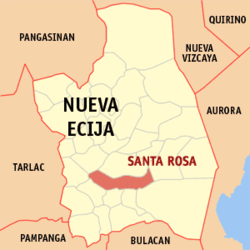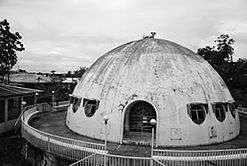Santa Rosa, Nueva Ecija
| Santa Rosa | ||
|---|---|---|
| Municipality | ||
|
| ||
| ||
 Map of Nueva Ecija showing the location of Santa Rosa | ||
.svg.png) Santa Rosa Location within the Philippines | ||
| Coordinates: 15°25′26″N 120°56′20″E / 15.42389°N 120.93889°ECoordinates: 15°25′26″N 120°56′20″E / 15.42389°N 120.93889°E | ||
| Country | Philippines | |
| Region | Central Luzon (Region III) | |
| Province | Nueva Ecija | |
| District | 3rd District | |
| Founded | 1917 | |
| Barangays | 33 | |
| Government[1] | ||
| • Mayor | Marita Angeles | |
| Area[2] | ||
| • Total | 147.15 km2 (56.81 sq mi) | |
| Population (2010)[3] | ||
| • Total | 69,467 | |
| • Density | 470/km2 (1,200/sq mi) | |
| Time zone | PST (UTC+8) | |
| ZIP code | 3101 | |
| Dialing code | 44 | |
| Income class | 1st class; partially urban | |
Santa Rosa is a first class municipality in the province of Nueva Ecija, Philippines. According to the 2010 census, it has a population of 64,503 people.[3] It is considered as a suburban municipality of Metropolitan Cabanatuan.
History
During the Outbreak of the Second World War, the Japanese Imperial forces did not enter and occupy the town municipalities at Santa Rosa, Nueva Ecija during the Japanese Occupation (1942-1944) through the Allied Liberation (1944-1945).
The founded of the local military establishment of the general headquarters and camp bases of the Philippine Commonwealth Army was found active on 1942 to 1946 and the 2nd Infantry Regiment of the Philippine Constabulary was found active again on 1944 to 1946 and stationed in the town municipality of Santa Rosa, Nueva Ecija.
Demographics
| Population census of Santa Rosa | ||
|---|---|---|
| Year | Pop. | ±% p.a. |
| 1990 | 40,439 | — |
| 1995 | 47,522 | +3.07% |
| 2000 | 51,804 | +1.87% |
| 2007 | 58,762 | +1.75% |
| 2010 | 64,503 | +3.45% |
| 2015 | 69,467 | +1.42% |
| Source: National Statistics Office[3] | ||
Local government
Pursuant to the Local government in the Philippines,[4][5] the political seat of the municipal government is located at the Municipal Town Hall. In the History of the Philippines (1521–1898), the Gobernadorcillo was the Chief Executive who holds office in the Presidencia. During the American rule (1898–1946) (History of the Philippines (1898-1946)), the elected Mayor and local officials, including the appointed ones, held office at the Municipal Town Hall. The legislative and executive departments perform their functions in the Sangguniang Bayan (Session Hall) and Municipal Trial Court, respectively, and are located in the Town Hall.
Santa Rosa's incumbent Mayor is Gen. Perfecto Per Palad and Vice Mayor is Antonio Romero.[1]
Barangays
Santa Rosa is politically subdivided into 33 barangays.[2]
- Aguinaldo
- Berang
- Burgos
- Cojuangco (Poblacion)
- Del Pilar
- Gomez
- Inspector
- Isla
- La Fuente
- Liwayway
- Lourdes
- Luna
- Mabini
- Malacañang
- Maliolio
- Mapalad
- Rajal Centro
- Rajal Norte
- Rajal Sur
- Rizal (Poblacion)
- San Gregorio
- San Isidro
- San Josep
- San Mariano
- San Pedro
- Santa Teresita
- Santo Rosario
- Sapsap
- Tagpos
- Tramo Chua
- Valenzuela (Poblacion)
- Zamora (Poblacion)
- Brgy Umali
Economy
Santa Rosa primarily depends on rice cultivation, vegetable production, commercial fishery, and tricycle sidecar fabrication. Just recently, the town started realizing its development potential.
The town's strategic location at the crossroads of two national highways: the Maharlika Highway and the Tarlac-Santa Rosa-Fort Magsaysay Road is accelerating its commercial and industrial development. It is also inevitably set to benefit from the spillover of Cabanatuan's built-up area.
As a result, Santa Rosa is gradually replacing agriculture with services and agro-industry as the main engines for growth. The stretch of Maharlika Highway is a growing commercial strip of local entrepreneurs competing with national businesses while the eastern part of the town is attracting investments in large commercial farms.
Concurrent to Santa Rosa's rapid growth is the buildup of perennially heavy traffic at the approach to the intersection of the national roads. To address the worsening situation, the local government teamed up with the Cabanatuan city government to construct a road that will bypass the town proper. As for Santa Rosa, only further growth is anticipated when Central Luzon Link Expressway and North Luzon East Expressway finally materialize.
Tourism and landmarks
Santa Rosa's main landmark includes Santa Rosa Supermarket or "Pamilihang Bayan ng Sta. Rosa", Santa Rosa Town Hall, Santa Rosa Town Park, Santa Rosa Central School, and St. Rose of Lima Parish Church. Other attractions which are most visited by tourists are The famous and old, round-shaped, miraculous chapel of San Mariano known as "The Miraculous Round Chapel of San Mariano", 18th Century Ancestral Houses in Sta. Rosa, a private "Gazebo" of Cruz Compound in San Mariano, American Air Base and rivers, Mga Munting Bahay-kubo, and scenic rice fields.
Some well-known schools, business and establishments in Santa Rosa Nueva Ecija are Holy Cross College, Sta. Rosa Metal Craft, Villa Riza Resort and Water Park, Almon Waterpark, Reynaldo's Grill and Restaurant, Hotel Consuelo and Restaurant, Allen Ville Resort, Windblows Resort, Harrie's Bake Shop, Gifts and Giveaways Shop, Mc'Koy's, Steven's Party Needs, Puno ice cream, Henry's Studio , And Reymill STEEL Products (Windmill).
St. Rose of Lima Parish Church
The 1879 St. Rose Of Lima Parish Church belongs to the Roman Catholic Diocese of Cabanatuan (Dioecesis of Cabanatuanensi, Suffragan of Lingayen-Dagupan, comprising 16 towns of Southern Nueva Ecija, Cabanatuan City, Palayan City and Gapan City; Titular: St. Nicholas of Tolentine, September 10; Most Reverend Sofronio A. Bancud, SSS, DD).
The Church is located at Maharlika Hway, Poblacion, Santa Rosa, 3101 Nueva Ecija. It is part of the Vicariate of St. Rose of Lima (Titular: St. Rose of Lima, Feast, Aug 23). Its current Parish Priest is Rev. Fr. Edwin C. Dizon.
St. Rose of Lima, T.O.S.D., (April 20, 1586 – August 24, 1617) was the first person born in the Americas to be canonized by the Catholic Church.[6]
1946 Holy Cross College and Chapel
The Holy Cross College (Former Holy Cross Academy) was founded by Rt. Rev. Msgr. Fernando C. Lansangan, Parish priest of the town of Sta. Rosa in 1985 as secondary school with two first year classes. In 1948, government recognition was granted to the school for its high school department. In 1981, the expansion of the school's curricular program was conceived. During SY 1982 – 1983, the MECS granted permit for the first and second year curriculum of the degree Bachelor of Arts and the first and second year curriculum for the Junior Secretarial Course were offered to the public In its 39th year of service to the community.[7][8]
Dr. Raquel Tioseco Sta. Ines, niece of the founder Priest took over the management of the college after his death. In all its 66 years of existence, HCC continues with additional TESDA programs in Restaurant Management, Computer Secretarial, and Electronic and Computer Technology; and six-month courses in Contact Call Center and Medical Transcription. HCC offers Masters in Education major in Mathematics and English.[9]
San Mariano Chapel or "The Miraculous Round Chapel of San Mariano"

San Mariano Chapel is a round-shaped chapel that is located in the core of Brgy. San Mariano Sta. Rosa, Nueva Ecija. This serves as a landmark of the said Barangay. It was named before a patron, "San Mariano". The land where it is located was privately owned by a devoted family. After total and complete renovation of the said chapel, The land title was donated to St. Rose of Lima Parish Church.
The Old Miraculous San Mariano Chapel was then renovated with the help of a devotee named Antonio M. Romero year 2000 after he recovered from a paralysis year 1989. The said devotee religiously attended the mass held at San Mariano Chapel then miraculously recovered from such an illness as stated. People of San Mariano early 1900's used to kneel when passing at the old church including their carabaos or "kalabaw" before farming at dawn as a sign of respect in the said chapel.
The chapel was believed to be miraculous and famous since as it was known to be visited by thousand devotees of "The Blessed Virgin Mary" and "Sto. Niño" during 1960s or 1970's. Miracles were actually witnessed by the people who visited the chapel and attended the mass held by the parish priest that time. Evidences of such miracles were collected and kept by group of families and people.
Feast of Sto. Niño were celebrated in San Mariano Chapel every 25 February where in a mass was held and simple gift giving and feeding for the children were organized by certain groups.
Reymill STEEL Products
Image gallery
-
Holy Cross College
-
Municipal road and Town hall
-
Santa Rosa Town Hall
-
Santa Rosa Park
-
Public market
-
Crossing, Junction
References
- 1 2 "Official City/Municipal 2013 Election Results". Intramuros, Manila, Philippines: Commission on Elections (COMELEC). 11 September 2013. Retrieved 21 October 2013.
- 1 2 "Province: Nueva Ecija". PSGC Interactive. Makati City, Philippines: National Statistical Coordination Board. Retrieved 21 October 2013.
- 1 2 3 "Total Population by Province, City, Municipality and Barangay: as of May 1, 2010" (PDF). 2010 Census of Population and Housing. National Statistics Office. Retrieved 2012-10-22.
- ↑ "Philippines : Gov.Ph : About the Philippines :". www.gov.ph. Retrieved 2009-03-28.
- ↑ http://www.chanrobles.com/localgov.htm
- ↑ Patron Saints Index: Saint Rose of Lima Retrieved on 2008-08-23.
- ↑ http://www.mb.com.ph/node/26231#.UPEmMeSyA8s
- ↑ http://group4neust.tripod.com/holy_cross/history.html
- ↑ http://philippinecollegecourses.com/central-luzon/nueva-ecija/holy-cross-college-nueva-ecija.html
External links
| Wikimedia Commons has media related to Santa Rosa, Nueva Ecija. |
- Philippine Standard Geographic Code
- Philippine Census Information
- Local Governance Performance Management System
 |
Aliaga | Cabanatuan |  | |
| Zaragoza | |
Laur | ||
| ||||
| | ||||
| Jaen | San Leonardo / Peñaranda | General Tinio |
